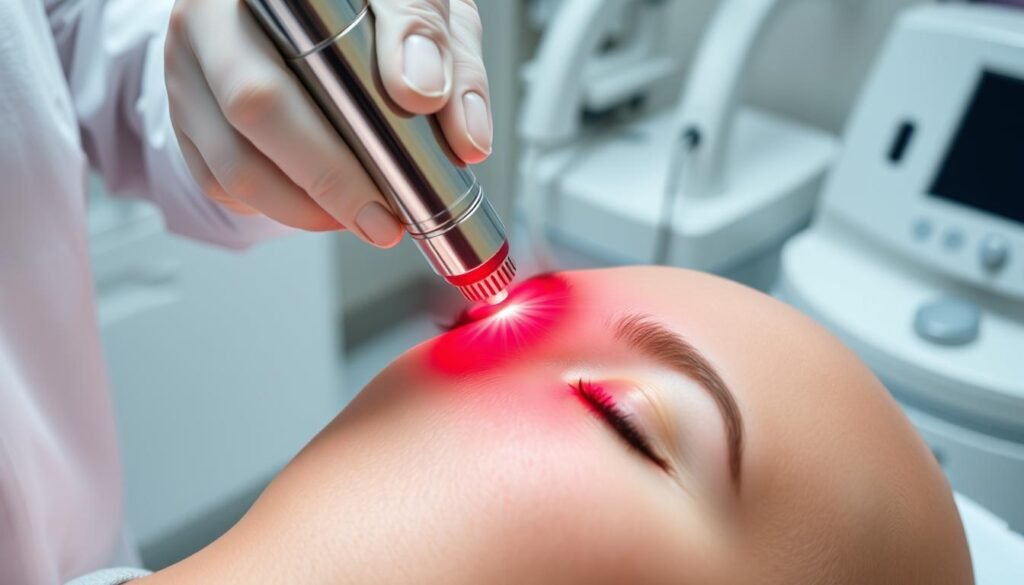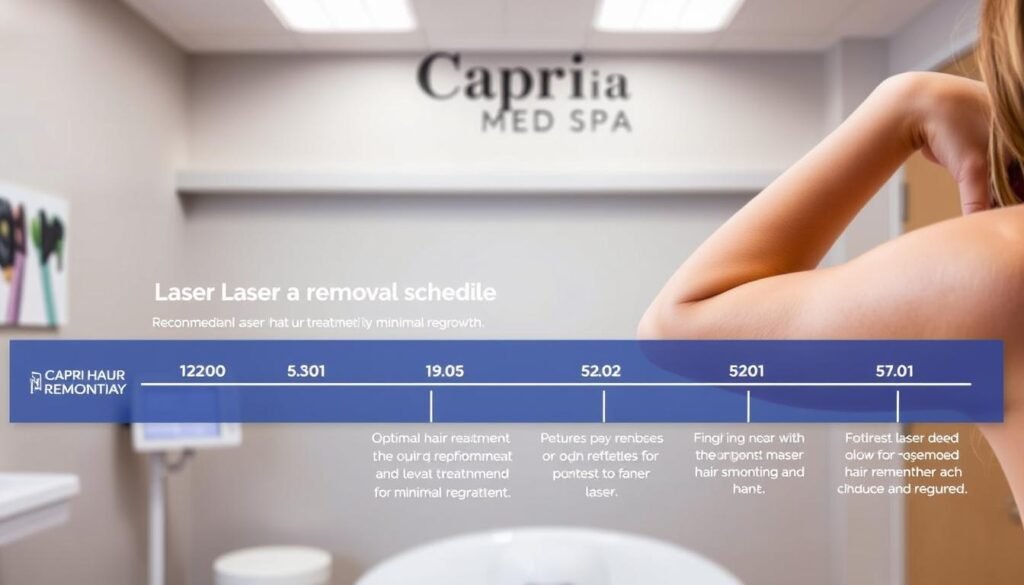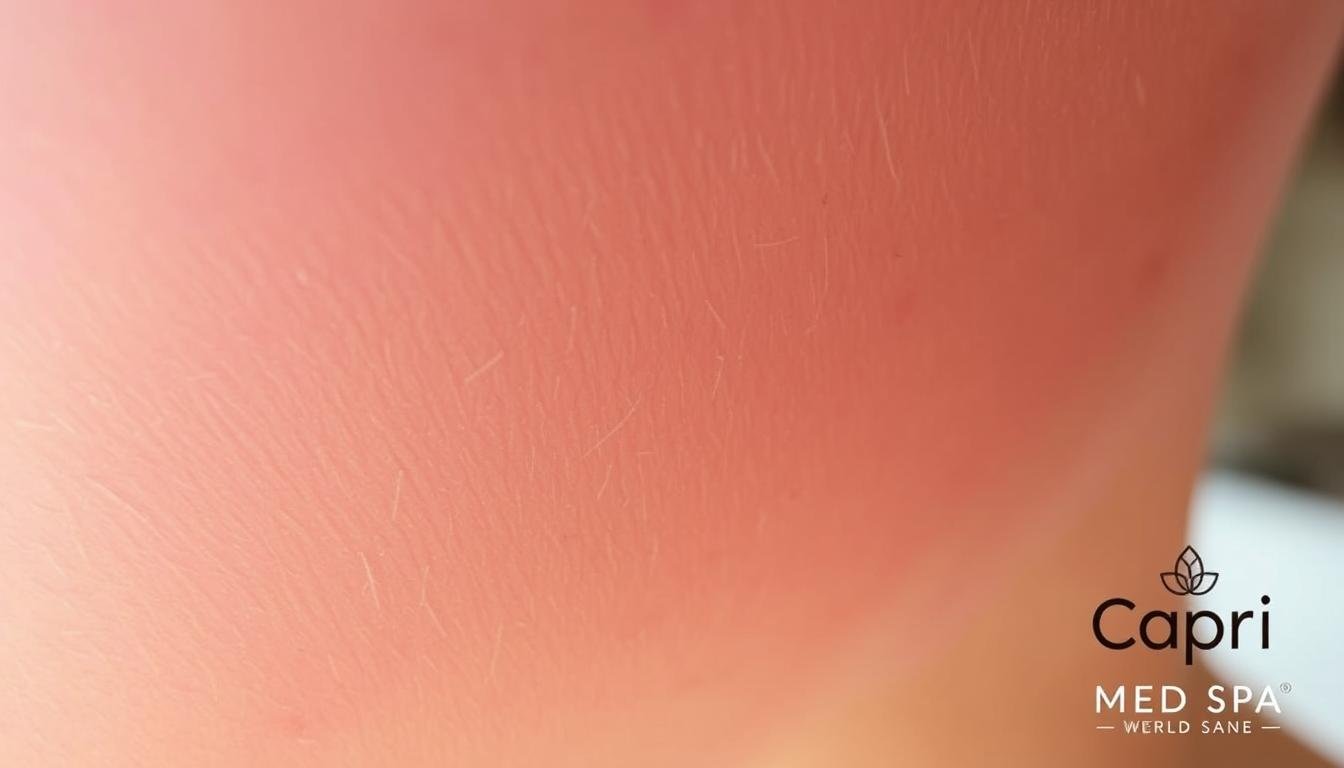At Capri Med Spa, we often get asked: “Will hair grow back if I stop laser treatments?” The answer is not just yes or no. Laser hair removal can reduce hair growth for a long time, but it doesn’t always remove it completely. Most people need 6-8 sessions, spaced 4-6 weeks apart, for the best results.
How much hair grows back depends on several things. If hair does grow back, it’s usually finer and lighter. Studies show that results can last up to two years or more before you might need touch-up treatments. Our Soprano Titanium technology is more effective than older systems, giving you smoother skin for longer.
Laser treatments are different from shaving or waxing because they gradually reduce hair density over time. Unlike temporary results from shaving or waxing, laser treatments weaken hair follicles with each session. Many clients see a 70-90% reduction in hair after their treatment course at Capri Med Spa.
Key Takeaways
- Laser hair removal provides long-term reduction, not permanent elimination
- Most people need 6-8 treatment sessions for optimal results
- Regrowth hair is typically finer, lighter, and sparser than before
- Touch-up treatments may be needed every 1-2 years for maintenance
- Results vary based on hair color, skin tone, and treatment area
- Hormonal changes can stimulate new hair growth even after treatment
- The Soprano Titanium technology at Capri Med Spa provides superior results
Understanding Laser Hair Removal Technology
Laser hair removal uses light to heat up hair follicles without harming the skin. It works best when hair is actively growing. The heat damages the follicle, reducing hair growth over time.
How Laser Targets Hair Follicles
The laser focuses on dark hair in follicles. Because not all hair is growing at once, you need multiple sessions. Usually, 6-8 sessions are needed for the best results.
Body areas respond differently to laser treatments. Facial hair grows back faster than hair on legs or the back. The best candidates have dark hair and light skin for the best contrast.
The Science Behind Permanent Hair Reduction
Permanent reduction means less hair growth over time, not complete removal. The FDA calls this a long-term decrease in hair. Many see thinner, lighter hair after treatments, with more improvement over time.
Most people see a 70-90% hair growth reduction after all treatments. Remaining hair is finer and lighter. This makes recovery from laser hair removal quick and easy.
Evolution of Laser Hair Removal Devices
Older laser tech was often painful and didn’t work well for all skin tones. The Soprano Titanium at Capri Med Spa is a big step up. It uses cooling tech for painless treatments and better results.
Today’s lasers have advanced cooling to protect the skin. They can treat more skin types and hair colors safely. Side effects usually go away within hours, not days.
Will Hair Grow Back If I Stop Laser?
Many people wonder if their unwanted hair will come back after stopping laser treatments. The answer depends on a few things. These include how many sessions you’ve had and your body’s unique biology.
Stopping laser treatments early can lead to some hair growing back. This is because not all hair follicles get enough energy to be permanently disabled.
The Truth About Hair Regrowth After Treatment
If you stop laser treatments too soon, you’ll keep the hair reduction you’ve got. But, for the best results, you need to finish your treatment plan. Experts say you need 6-8 sessions for the best outcome.
Those who stop after 3-4 sessions will see some hair return. But, it’s usually finer and grows slower than before.
The effects of stopping laser treatments vary from person to person. After four sessions, many hair follicles can produce new hair. That’s why finishing your treatment is key for lasting results.
Difference Between Permanent Reduction vs. Permanent Removal
It’s important to understand the terms used. The FDA says laser treatments can only reduce hair, not remove it completely. This means you’ll see a big decrease in hair growth, but not a complete stop.
True permanent removal means no hair will ever come back. But, this is not guaranteed with laser treatments. Some follicles might start working again if treatments are stopped too soon.
What Research Shows About Long-Term Results
Studies show that following the full treatment protocol leads to great results. Here’s what research found:
- Most patients keep 70-90% hair reduction for years after treatment
- Any new hair is finer and lighter than before
- Occasional maintenance sessions can handle any regrowth
- Modern systems like Soprano Titanium give better results than older ones
Will hair grow back if I stop laser treatments? It might, but finishing your treatment greatly reduces this chance. This way, you can enjoy smooth, hair-free skin for years.
Factors Affecting Hair Regrowth After Laser Treatment
Knowing what affects laser hair removal can help you know what to expect. The area treated impacts how fast hair grows back. Facial areas grow hair faster than body parts because of hormones.
Your hair and skin type also play a big role. Dark hair and light skin work best with laser treatments. About 10-30% of hair follicles might stay active after treatment, leading to some regrowth.
When hair does grow back, it’s usually finer and lighter. Body parts like the bikini line and underarms keep hair away longer. This is why getting a treatment plan tailored to you is key for effective laser hair removal in La.
The most dramatic improvements usually need six sessions, 4-8 weeks apart. After these, many clients go years without much hair growth. Others might need annual touch-ups.
Hormones can make results unpredictable. Changes like pregnancy or menopause can cause new hair growth. This is why some women see hair on their chin or upper lip during these times.
The way treatment is done and the technology used also matter a lot. New systems with cooling tech make treatments more comfortable. They also work better at stopping hair growth, leading to smoother skin for longer.
The Soprano Titanium Advantage in Preventing Hair Regrowth
Capri Med Spa offers the Soprano Titanium system, a top choice for stopping hair growth after laser treatments. This system is at the cutting edge of permanent hair reduction. It works well on all skin types, unlike older laser systems.
How Cooling Technology Improves Comfort and Results
The Soprano Titanium has a cooling system that makes laser hair removal better. It keeps the skin safe while reaching deep into hair follicles. This way, treatments are more effective and less painful.
Thanks to the cooling, treatments can get hot enough to stop hair growth without harming the skin. This means better results without needing time to recover.

SHR Technology: The Painless Alternative
The Soprano Titanium uses SHR technology for gentle hair follicle heating. It avoids the sudden, painful zaps of old lasers. This makes treatments comfortable for everyone.
People who were scared of laser treatments because of pain love SHR. It lets them finish sessions without stopping, making treatments more effective.
Why Soprano Titanium Delivers More Permanent Results
The Soprano Titanium has three laser wavelengths that target all hair types. This means every hair gets treated well, reducing regrowth chances a lot.
Its benefits include:
- Up to 80% permanent hair reduction capacity
- Approximately 20% of treated hair eliminated per session
- FDA approval for all skin colors including darker tones
- In-motion technology ensuring consistent energy application
- Larger spot size providing complete treatment area coverage
Most people see the best results after 6-8 sessions, spaced six weeks apart. Soprano Titanium treatments mean you don’t need to come back as often as with old systems. It’s a long-term fix for unwanted hair.
Common Misconceptions About Laser Hair Removal Reversal
Many people wonder about laser hair removal reversal and what happens after treatment. The truth is different from what many think. Let’s set the record straight about this popular hair reduction method.
Debunking Myths About Hair Growth Cessation
The idea that laser hair removal is permanent for everyone is not true. It significantly reduces hair growth, but it’s more accurate to say it’s a permanent hair reduction. Studies show that after 4-6 treatments, most people see up to 90% less hair in targeted areas.
Another myth is that hair will return completely after laser removal. The truth is, laser targets hair in the active growth phase. This is why you need multiple sessions. Some fine, light hairs might appear years later due to hormonal changes or aging, not because the treatment failed.
Many believe one treatment is enough, which is a common myth about laser hair removal. But, lasting results usually need 4-6 sessions, spaced about a month apart.
What Happens When You Stop Treatments Mid-Course
Stopping laser treatments before finishing your course leaves some follicles partially damaged. This means some hairs might grow back, but they’re often finer and lighter than before.
The time it takes to notice regrowth varies by person. Usually, those who stop mid-course see hair return in 2-6 months. Areas with denser, coarser hair like the bikini line may show regrowth sooner than areas with finer hair.
At Capri Med Spa, the Soprano Titanium technology offers superior, long-lasting results. It delivers consistent energy to hair follicles, reducing the chance of hair return even if maintenance sessions are missed. Personalized treatment plans ensure each client gets the right number of sessions for their hair type and growth patterns.
Recommended Treatment Schedule for Minimal Hair Regrowth
Getting lasting results from laser hair removal depends on a good treatment schedule. Hair grows in cycles, so timing between sessions is key. For the face, book appointments 4-6 weeks apart. For the body, wait 6-8 weeks.

Most people need six treatments for the best results. Each session weakens hair follicles. Missing sessions can undo progress, as follicles can grow back.
Capri Med Spa’s Soprano Titanium tech makes treatments more efficient. It has cooling tech for less irritation and faster healing. This keeps you on track without delays.
After 2-3 sessions, hair grows back finer and lighter. By session six, you might not need maintenance for months or years. Small areas like the upper lip take 5 minutes. Larger areas like legs or back take an hour.
Following your schedule is an investment in lasting results. Those who finish the course might only need one or two maintenance sessions a year.
Hormonal Changes and Their Impact on Hair Growth After Laser
Hormonal changes can affect whether hair grows back after laser removal. Even if treatments reduce hair by up to 90%, new hair can start growing again. This happens because of changes in hormones throughout our lives.
Pregnancy and Postpartum Hair Regrowth
Pregnancy brings big hormonal changes that can make hair grow in treated areas. Many women see unwanted hair on their face, belly, or back during pregnancy. This is because pregnancy hormones wake up dormant hair follicles.
It’s best to wait until after pregnancy and breastfeeding to start treatments again. Specialized laser treatments in North Hollywood can help with postpartum hair changes with little discomfort.
PCOS and Other Hormonal Conditions
Polycystic ovary syndrome (PCOS) affects up to 10% of women, causing hair growth due to high androgen levels. For those with PCOS, laser treatments might not stop hair growth completely. Hormonal imbalances can keep new hair follicles active.
People with hormonal disorders often need 8-12 sessions, not the usual 6-8. Working with hormone management can lead to better results for permanent hair reduction.
Aging and Its Effect on Hair Growth Patterns
As we get older, our hormone levels change. During menopause, lower estrogen can make facial hair grow back in treated areas. On the other hand, some people naturally lose hair as they age, making laser treatments more effective over time.
Regular maintenance sessions are key to managing these changes. Touch-ups are needed every 12-18 months. New cooling technologies make these sessions more comfortable, reducing the chance of hair coming back after laser removal.
Maintenance Sessions: Why They Matter for Long-Term Results
Laser hair removal can give you lasting results, but you need to keep up with it. After your first treatments, you might need to go back for more. In 2024, people in NYC might need to get laser hair removal every six months to a year.
How often you need to go back depends on your hair. Darker and thicker hair might need less treatment than lighter, finer hair. Also, facial hair might need more sessions than body hair.
New laser tech could mean you don’t need to go as often. Talking to a laser hair removal expert can help you figure out the best schedule for you. They can look at your hair growth and how you react to treatments to make a plan just for you.
FAQ
Does hair grow back after laser hair removal?
Laser hair removal doesn’t remove hair forever in every case. The outcome depends on several things. These include the area treated, hair type, skin color, and the laser technology used.
How do lasers target hair follicles?
Lasers aim at the melanin in hair follicles. This stops them from growing new hair. You need more than one session to get all hairs.
What does “permanent hair reduction” actually mean?
It means some follicles are stopped from growing hair, but not all. Some might grow back. Newer technologies like Soprano Titanium give better results.
What happens if I stop laser hair removal treatments before completing the recommended course?
Stopping early can lead to some hair growing back. This is because not all follicles got enough energy. It’s key to finish the whole treatment for best results.
How effective are laser hair removal results long-term?
Many people keep 70-90% of hair reduction for years after treatment. Any new hair is usually finer and lighter. Capri Med Spa’s Soprano Titanium offers top results.
What factors influence hair regrowth after laser treatment?
Several things can affect results. These include the area treated, hair and skin color, treatment number, age, hormones, and lifestyle. Capri Med Spa tailors plans to these factors.
How does Capri Med Spa’s Soprano Titanium system prevent hair regrowth?
Its cooling tech, gentle SHR method, and multiple wavelengths make disabling hair follicles more effective. It’s also less painful than older systems.
What are common misconceptions about laser hair removal reversal?
Some think laser results are always permanent or that all hair will grow back. Capri Med Spa sets the record straight and offers realistic expectations.
What is the optimal treatment schedule for minimizing hair regrowth?
Treatments should be spaced 4-6 weeks apart for the face and 6-8 weeks for the body. Completing 6-8 sessions with Soprano Titanium is key for lasting results.
How do hormonal changes affect laser hair removal results?
Hormonal shifts, like during pregnancy or with PCOS, can lead to new hair growth. Capri Med Spa offers customized plans to manage these changes and their impact on hair.



1 Comment
Scalp Micropigmentation in Toluca Lake - Capri Med Spa
June 18, 2025[…] more on cosmetic treatments, check out our laser hair removal […]